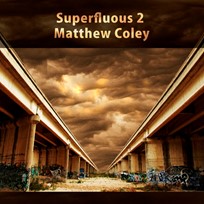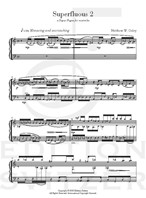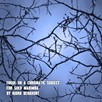
Superfluous 2
Composer: Matthew Coley
Instrument: Marimba
Level: Advanced
Published: 2010
Price: €12.00
Item details
-
Description +
-
Duration: 2.30 min.
Superfluous 2 was written in 2009 and is the next not-so-logical step from the more tonal and traditional Superfluous 1. The title is a play on the words “super fugue”, but also seemed befitting to the pieces and probably the ones to follow for reasons only found in the learning and performing of such a composition. While it was fun to write a fugue, and especially one of such modern construction, is it really necessary to write something of such complicated technical demand for a solo percussion instrument and player? If you have a slight addiction to fugues, like I do, then your answer, like mine, is probably a hushed, yet confident, yes.
The architecture of the fugue has always appealed to me on a level that seems superior to many other forms. To this effect, my composition, Concealed Chambers, was written in 2000 and is a solo marimba work in five movements. Movement three, Cortex, begins as a three-part fugue and ends as a four-part, of which the subject and harmonic language are the primary basis for the material in the other four movements. Beethoven made no mistake when some of his most memorable compositional moments are the “Ode to Joy” fugue of the last movement of the Ninth Symphony and the statuesque Grosse Fugue in Bb major, Opus 133 for string quartet. The fugues of Bach’s and Shostakovich’s books of 24 are an example of some of the most amazing variety of character that music and the structure of the fugue can exhibit. The award-winning composer, Bjorn Berkhout, who has written fugues for me, once said, “The fugue was the last great contribution to Western-classical music.”
I hope with Superfluous 2 you can bask in the joy of performing a work that follows in the steps of such a venerable and superior musical structure, while knowing that it is not a transcription, but actually written for the marimba with the spirit of any other contemporary composition. Also, remember to enjoy that what you are doing is super, but also superfluous.
-
-
Instrumentation +
-
Marimba (5-octave)
-
-
About the composer +
-
Matthew Coley is a marimba, percussion, and dulcimer artist specializing in contemporary solo and chamber music and concerti. He is currently professor of percussion at Iowa State University, and holds degrees from Northwestern University and the University of North Texas. Matthew performs regularly as a soloist throughout the US and Europe, traveling annually to Chisinau, Moldova to perform concerts, concerto premieres, and masterclasses.
He has performed as soloist with such ensembles as San Francisco Sinfonietta, Millen-nium Chamber Players, Moldavian Philharmonic and Tele-Radio Orchestras, and Third Coast Percussion. In 2010, he will also perform as soloist with several ensembles, finish his first solo marimba album, and tour with percussion duo SI2.
In 2009 he was featured in Time Out Chicago Magazine, performed the US premiere of Marcin Blazewicz’s Concerto Rustico for marimba and strings, the World premiere of Ghenadie Ciobanu’s Breeze of the South Latitudes Marimba Concerto, and his composition, Journey for Solo Marimba, Piano, and Percussion Ensemble was featured as part of the University of North Texas Percussion Ensemble concert at the Percussive Arts Society International Convention.
In 2008, Matthew place third in the prestigious 5th World Marimba Competition Stuttgart, and is the first American to ever place in this competition. In 2005, he placed third in the Minnesota Orchestra Young Artist Competition, and in 2000 won first in the Music Teachers National Association Solo Percussion Competition and the Percussive Arts Society Marimba Concerto Competition.
Matthew is founding artistic director of SONIC INERTIA, and an active member in the percussion duo SI2 with Cory Hills. He collaborates regularly with choreographers and is most recently working with Valerie Williams and Co’Motion Dance Theatre. Matthew has presented concerts and masterclasses at several universities throughout the US, some of which include Louisiana State University, University of Maryland, and Virginia Commonwealth University. He is endorsed and published by Innovative Percussion, endorsed by Dynasty and Grover Percussion, and published by Edition SVITZER. He can be found on the web at www.hearmatthewcoley.com.
-
-
Reviews +
-
Review (Percussive Notes, March (58) 2012)
Obviously aware of the extreme demands of this composition, Matthew Coley poses the following question: “Is it really necessary to write something of such complicated technical demand for a solo percussion instrument and player?” In order to expand the repertoire and vocabulary for the instrument, there is always a need to produce new works for all ability levels. It is not as if Coley did not warn the performer of the difficulty in the title.
Do not be fooled by the duration of this short, modern fugue. Approximately two minutes and 30 seconds, there are plenty of elements to challenge advanced performers. With the presence of a sixteenth-note pulse almost always apparent, all four-mallet stroke types are required. Using intervals that exceed an octave, shifts to a second are made within the duration of one sixteenth note. A rapid, controlled alternating stroke technique is needed in the left hand to execute a descending thirty-second note passage that incorporates chromatic neighbor tones. Independence is a necessity as a large wingspan frequently separates the hands during this work.
A note to experienced marimbists: Leave your ego at the door. Extreme independence and technical facility are a must in order to attempt this work. A mature musician will ensure that the density and demands do not interfere with compositional ideas.—Darin Olson
-
-
Credits +
-
Front Cover graphics and layout: Ronni Kot Wenzell
Engraving: Matthew Coley/Johan Svitzer
Printed in Copenhagen, Denmark
Copyright © Edition SVITZER
www.editionsvitzer.com
-





